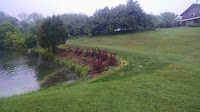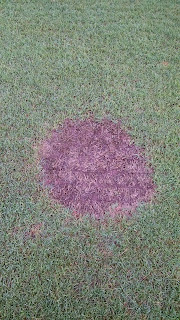Happy Memorial Day. The unofficial start to summer is here
and so is the meat of the golf season. This past weekend saw temperatures soar,
many golf rounds played, and another member tournament.
When the golf season ramps up so does our diligence in caring
for the turf. The stress that Mother Nature applies, in combination with stress
that comes from maintenance and golfers, can take a toll. Recently, some
questions have arisen regarding our cup changing “schedule” and why we
seemingly change cups so few times. Similar to everything we do, our schedule
is only a framework that takes into account many factors including: member
satisfaction, turf health, outside event scheduling, and weather.
Our regular routine consists of changing all 18 cups plus 5
practice green cups on Tuesday. We do not change any cups on Wednesdays. We
then change odd numbered holes on Thursday and Saturday and even numbered holes
on Friday and Sunday. We also change the practice green cups again on Friday.
What this rotation amounts to is every cup 1-18 being changed 3 times per week
and the practice cups being changed 2 times per week. However, a cup that was
not changed freshly in the morning plays no differently than a cup that was
changed freshly. The only difference is visual, and depending on how many
people played and how careful they were when reaching in for their ball, the
visual difference would be minimal at most. You can also read here
the other factors we consider when selecting pin locations. There are several dynamics
that have led us to this rotation and deter us from increasing the amount of
times per week that any given cup gets changed.
To cut a cup, we literally cut a piece of the turf out and
move it to the previous hole. We call this piece of the green the plug. This
rotation continues endlessly. The reason this works so well is because the tool
we use to cut the cup takes all the soil and roots of the turf from each place
along to the next place. The turf barely knows it was moved. However, it is
still visible on the surface where the previous plug is on a green. It is also
much less smooth to putt across an old plug. We try and stay away from old
plugs to give the best possible putting area around a new cup. When the turf is
growing well, an old plug can be healed well enough to putt across in 3-5
days. If we are changing cups too often,
though, we are back to the same areas too soon for the plug to heal. Repeat the
process through the season and it isn’t long before people are forced to putt
over old plugs constantly.
With regard to outside events, many of the outings that we
host have prizes on par 3 holes for holes-in-one. Each of these usually
requires a minimum distance from which the hole is played to qualify. To
accommodate the necessary yardage, we put the pins either in the middle or back
of the green. By doing this we allow the tees to be moved up closer, resulting
in an easier hole for the outing. The alternative would be if we put the cup in
a front location, then the tees would be moved farther back to achieve the
minimum yardage for the prize and a more difficult hole. A prime example is
hole #9. If the pin is in the front and the tees are back to gain the necessary
prize yardage, then there is very little ground short of the green on which to
land a shot, resulting in shots in the water (or in bunker or rough on other
par 3’s). This can slow the pace of play down further than outing pace of play
already is. However, when the pin is moved to the middle or back, then there is
10-20 yards of green short of the cup on which a shot can land, resulting in
putts or short chips for second shots. So, subtracting all front pin locations,
we only have 2/3 of the available cup locations for those outings all season.
Green speeds also play a role in determining our frequency
of cup changing. As we increase green speeds, the area available to place a cup
decreases. What might be a manageable slope when the greens are rolling 9’ suddenly
becomes impossible to stop a putt when the greens are rolling 11’ or faster. So
now, not only are severe slopes off limits, but so are marginal slopes. Again,
the area available is shrinking.
The result of all of these factors has led us to our current
schedule. Because we come back to the same areas sooner, those areas get less
time to heal from stress. Turf health would begin to decline. At this point, we
either take certain areas out of rotation, further shrinking our available
space and further stressing other areas, or we raise the mowing height and slow
the greens down so we can use previously unavailable space. Once it reaches
this point, no one is happy.
Through the year, there are certain times where we do increase
our cup changing frequency. Tournaments are a good example. However, we can’t
increase our frequency for EVERY tournament because of the number of
tournaments at the club. Depending on what other events are occurring adjacent
to the tournament and what the weather is like, also factors in to whether we
increase frequency.
So, we have thought through the scenarios and developed this
schedule. It isn’t perfect and does not completely satisfy everyone, but we do
not make the decision lightly and we do not make the decision without reasons.
Etiquette Reminder of the Month
When you splash bunker sand onto the green after your shot,
please brush away any large piles or clumps that may have ended up on the
green.
See you on the course!
Joe
jvillegas@bwrc.org






















